Introduction: A Flemish Master of Observation
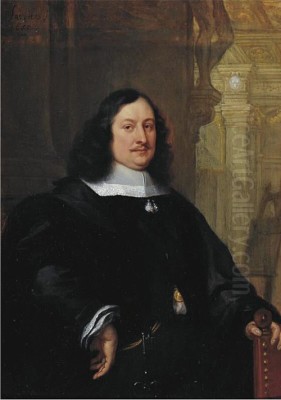
David Teniers the Younger stands as one of the most prolific, versatile, and influential painters of the Flemish Baroque period. Born into an artistic dynasty in Antwerp in 1610 and living until 1690, his long career spanned a dynamic era in the Southern Netherlands. While adept at history painting, portraiture, landscape, and even still life, Teniers carved a unique and enduring niche for himself through his lively and insightful depictions of peasant life. His canvases, often filled with humor, keen observation, and a remarkable sensitivity to human nature, captured the everyday world of Flanders with unparalleled vibrancy, earning him widespread acclaim during his lifetime and a lasting legacy in the annals of art history.
Early Life and Artistic Foundations in Antwerp
David Teniers the Younger was baptized in Antwerp on December 15, 1610. Artistry was in his blood; his father, David Teniers the Elder (1582-1649), was a respected painter himself, known for his historical and mythological scenes, often influenced by his time in Rome and his association with artists like Adam Elsheimer and Peter Paul Rubens. It was under his father's tutelage, beginning around 1626, that the young David received his initial training. This familial connection provided a solid foundation in the techniques and traditions of Flemish painting.
Antwerp, during Teniers' youth, was a major artistic hub, still basking in the glow of its Golden Age, though facing economic and political challenges. The city's vibrant artistic community was centered around the Guild of St. Luke, the professional organization for painters and other craftsmen. Teniers the Younger formally entered this world in 1632 or 1633 when he was admitted as a master into the Antwerp Guild. This membership was a crucial step, allowing him to take on pupils and sell his work independently.
Influences and Early Style Development
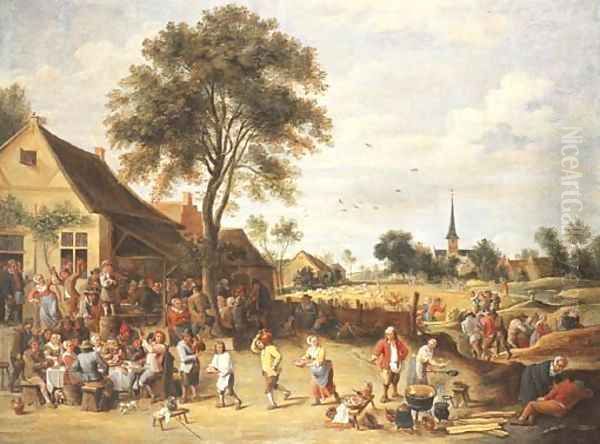
While his father provided the initial training, Teniers the Younger quickly absorbed other influences. The most significant early impact came from Adriaen Brouwer (c. 1605-1638), a fellow Flemish artist renowned for his raw, expressive, and often gritty depictions of peasant brawls, tavern scenes, and low-life subjects. Brouwer's energetic brushwork and his focus on the less idealized aspects of rural life clearly resonated with Teniers in his formative years. Teniers' early works often feature similar themes – smokers, drinkers, card players in dimly lit interiors – though generally rendered with a slightly less coarse touch than Brouwer's.
However, the towering figure of Peter Paul Rubens (1577-1640) also cast a long shadow over the Antwerp art scene, and Teniers was not immune to his influence. While their primary subjects differed, Teniers likely absorbed lessons from Rubens' dynamic compositions, rich color palettes, and masterful handling of light. Furthermore, a significant personal connection was forged: Rubens was a friend and collaborator of the Brueghel family, into which Teniers would soon marry.
Marriage, Family, and Rising Status
A pivotal moment in Teniers' personal and professional life occurred in 1637 when he married Anna Brueghel. Anna was the daughter of Jan Brueghel the Elder (1568-1625), the celebrated "Velvet" Brueghel known for his exquisite flower paintings and detailed landscapes, and the granddaughter of the legendary Pieter Bruegel the Elder (c. 1525-1569), the patriarch of Flemish genre painting. This marriage was a strategic coup, connecting Teniers directly to one of the most prestigious artistic families in Flanders. Peter Paul Rubens himself served as a witness at their wedding, highlighting the close ties between these leading artistic figures.
The marriage brought not only social prestige but also likely financial benefits and enhanced professional opportunities. Teniers' association with the Brueghel legacy undoubtedly bolstered his reputation. The couple would go on to have several children, including David Teniers III (1638-1685), who also became a painter, carrying the family's artistic tradition into another generation, though his success never rivaled his father's. Another son, known as David Teniers IV, also pursued painting. The Brueghel connection cemented Teniers' place within the elite circles of Antwerp's art world.
Maturing Style: The Peasant World Comes Alive
Through the late 1630s and 1640s, Teniers moved beyond the direct influence of Brouwer and developed his own distinctive style, which would become his hallmark. While still focusing on rural and village life, his approach became more refined, his palette brightened, and his settings often expanded from dark interiors to sunnier outdoor scenes. He excelled at depicting kermesses (village fairs or festivals), weddings, and outdoor games, populating them with numerous small, lively figures engaged in various activities – dancing, eating, drinking, playing music, or simply conversing.
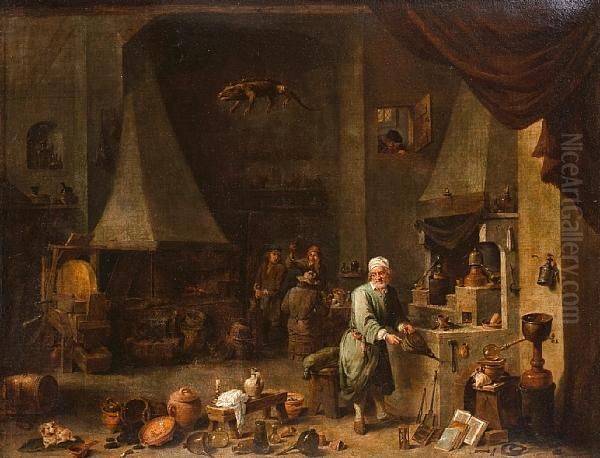
His genius lay in his ability to capture the atmosphere of these communal gatherings with a sense of cheerful energy, while also paying meticulous attention to detail. Figures are individualized, their postures and gestures conveying personality and narrative incident. He rendered textures – rough-spun clothing, earthenware jugs, wooden barrels, thatched roofs – with convincing realism. His use of light became more sophisticated, often employing silvery tones and subtle atmospheric perspective to create a sense of depth in his landscapes and village squares. Works like The Village Feast exemplify this mature style, showcasing his skill in organizing complex multi-figure compositions and capturing the boisterous spirit of peasant celebrations.
Diversification of Themes
While best known for his peasant scenes, Teniers was remarkably versatile. He painted landscapes that often served as backdrops for his genre scenes but also stood as independent works, capturing the flat, expansive countryside of Flanders under changing skies. He produced portraits, though less frequently than genre scenes, often depicting fellow artists or members of the nobility. Still life elements feature prominently within his interiors, rendered with characteristic precision.
Teniers also explored more unusual themes. He painted numerous "guardroom scenes," depicting soldiers relaxing, gambling, or inspecting armor and weapons, a genre popular in the Dutch Republic and Flanders during this period of frequent military activity. Another recurring subject was the alchemist in his laboratory, surrounded by the paraphernalia of his mystical and scientific pursuits – furnaces, alembics, mortars, and books. These works, such as Self-Portrait as an Alchemist or Interior of a Laboratory with an Alchemist, tapped into contemporary fascination with science and the occult, often blending meticulous realism with an air of mystery or gentle satire. Religious and mythological subjects also appeared in his oeuvre, sometimes treated traditionally, other times incorporated into allegorical scenes or even peasant settings, like depictions of the Temptation of St. Anthony set amidst fantastical creatures.
The Call to Brussels: Court Painter to the Archduke
Teniers' reputation grew steadily, extending beyond Antwerp and Flanders. His skill, productivity, and the appealing nature of his subjects made his work highly sought after by collectors and dealers. A major turning point came in the late 1640s. Around 1647, he was appointed court painter and curator ('ayuda de cámara') to Archduke Leopold Wilhelm of Austria, the Governor of the Spanish Netherlands, whose court was based in Brussels. This prestigious appointment marked a significant elevation in Teniers' status.
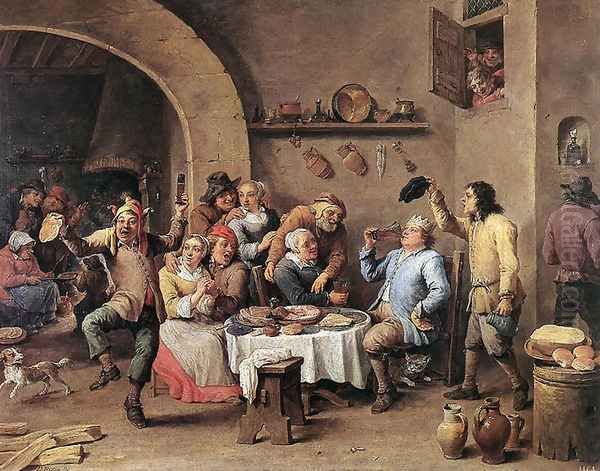
By 1651, Teniers had relocated his family and workshop from Antwerp to Brussels to better serve the Archduke. This move placed him at the center of political and cultural power in the Southern Netherlands. His duties were twofold: not only did he continue to paint original works, often for the Archduke himself, but he was also entrusted with managing and documenting the Archduke's magnificent art collection, one of the finest in Europe at the time.
The Theatrum Pictorium: A Monumental Catalogue
One of Teniers' most remarkable achievements during his service to Archduke Leopold Wilhelm was the creation of the Theatrum Pictorium ("Theatre of Painting"). This was the first illustrated catalogue of a major art collection ever published. To produce it, Teniers painted small-scale copies (modelli) of over 240 Italian paintings (primarily Venetian works by artists like Titian, Veronese, and Tintoretto) from the Archduke's collection. These copies served as the basis for engravings executed by a team of printmakers under Teniers' supervision.
Published in 1660, the Theatrum Pictorium was a groundbreaking work. It disseminated knowledge of the Archduke's Italian masterpieces throughout Europe, influencing artists and connoisseurs far beyond Brussels. The project showcased Teniers' organizational skills, his connoisseurship, and his remarkable ability to capture the essence of other artists' styles in his small copies. It remains an invaluable resource for art historians studying the provenance of paintings and the history of collecting. This massive undertaking further solidified Teniers' international reputation not just as a painter, but as a knowledgeable figure in the wider art world.
Continued Patronage and Artistic Recognition
Even after Archduke Leopold Wilhelm returned to Vienna in 1656, Teniers remained in Brussels and continued to enjoy elite patronage. He served the Archduke's successor as Governor, Don Juan of Austria (the illegitimate son of Philip IV of Spain), and received commissions from prominent figures across Europe, including King Philip IV of Spain himself, Queen Christina of Sweden, and William II, Prince of Orange. His paintings were highly prized diplomatic gifts and essential components of aristocratic collections.
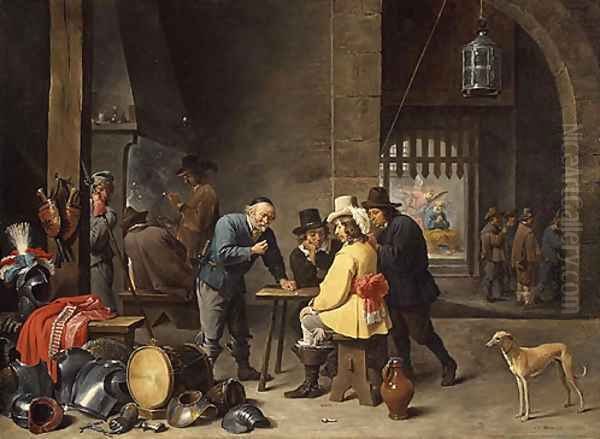
His success brought considerable wealth and social standing. He lived in a grand house near the Brussels court and invested in property. His influence extended to the institutional level as well. Teniers played a key role in the establishment of the Antwerp Royal Academy of Fine Arts. Although primarily based in Brussels by this time, he used his influence and connections, petitioning King Philip IV for a royal charter, which was granted around 1663-1664. This initiative aimed to elevate the status of artists and provide structured training, reflecting Teniers' commitment to his profession. In recognition of his achievements and status, he was eventually granted a patent of nobility, further cementing his position in society.
Later Life: Success and Struggles
Teniers' personal life saw significant changes in his later years. His first wife, Anna Brueghel, died in 1656. Later that same year, he remarried. His second wife was Isabella de Fren, the daughter of Andries de Fren, secretary to the Council of Brabant. This marriage connected him to the administrative elite of Brussels and reportedly brought a substantial dowry. However, his later life was not without difficulties.
Sources suggest that despite his considerable earnings, Teniers sometimes faced financial strain, possibly due to a lavish lifestyle or ambitious investments. There were also reports of family disputes, including conflicts with his children from his first marriage, particularly his son David Teniers III, possibly over inheritance or financial matters. Lawsuits involving family members seem to have marked his later decades, suggesting that personal harmony did not always accompany professional success. Despite these troubles, he continued to paint, although his output may have slowed in his final years. He died in Brussels on April 25, 1690, at the venerable age of 79, leaving behind an immense body of work.
Artistic Legacy and Influence
David Teniers the Younger was one of the most successful and widely imitated painters of his time. His influence was immediate and widespread. His peasant scenes, in particular, spawned countless followers and imitators throughout Flanders and the Dutch Republic. His works were frequently copied and adapted for other media, notably Brussels tapestries, which helped to popularize his compositions even further.
His impact extended into the 18th century, particularly in France. French Rococo artists, most notably Jean-Antoine Watteau (1684-1721), admired Teniers' depictions of rural life and his delicate handling of light and atmosphere. While Watteau transformed these rustic themes into more elegant and melancholic fêtes galantes, the influence of Teniers' subject matter and compositional approaches is undeniable. Other Rococo painters like François Boucher also looked to Teniers' pastoral scenes. His popularity among collectors remained high throughout the 18th and 19th centuries.
Teniers in Collections Worldwide
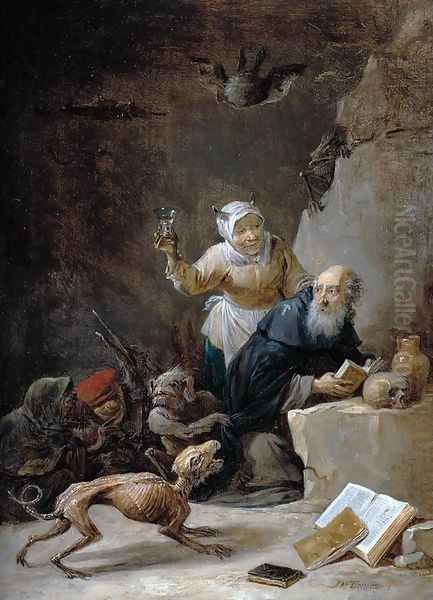
The enduring appeal and historical importance of David Teniers the Younger are reflected in the presence of his works in major museums and collections across the globe. His prolific output means that many institutions hold examples of his art. The Prado Museum in Madrid, Spain, has a significant collection, partly due to the Spanish royal patronage he enjoyed; works like The Archduke Leopold Wilhelm in his Picture Gallery in Brussels and versions of The King Drinks (celebrating Epiphany) are highlights.
The Hermitage Museum in St. Petersburg, Russia, also boasts a substantial number of Teniers' paintings. In London, the Wallace Collection holds several fine examples, showcasing his genre scenes within a rich context of European art. The Alte Pinakothek in Munich houses key works, including the intriguing Self-Portrait as an Alchemist. The Metropolitan Museum of Art in New York features paintings like Guardroom with the Deliverance of Saint Peter. Other notable holdings can be found in the Louvre in Paris, the Kunsthistorisches Museum in Vienna (which inherited much of Archduke Leopold Wilhelm's collection), the Rijksmuseum in Amsterdam, and numerous regional museums across Europe and North America. His works also continue to appear at major auction houses like Dorotheum in Vienna, Sotheby's, and Christie's, attesting to his continued market presence.
Conclusion: An Enduring Vision of Flemish Life
David Teniers the Younger occupies a central place in the history of 17th-century Flemish art. He inherited a rich artistic tradition from his father and the Brueghel dynasty, absorbed the innovations of contemporaries like Brouwer and Rubens, and forged a unique and highly successful style. His depictions of peasant life, village festivals, tavern interiors, and diverse other subjects offer an unparalleled window into the world of Flanders during the Baroque era.
His technical skill, characterized by fine brushwork, harmonious color, and masterful handling of light, combined with his keen observation, humor, and empathy for his subjects, resulted in works of enduring charm and appeal. As a court painter, curator, catalyst for the Antwerp Academy, and creator of the groundbreaking Theatrum Pictorium, his influence extended far beyond his own canvases. Though his reputation perhaps dipped slightly with the changing tastes of modernism, academic evaluation consistently recognizes him as a master of genre painting and a key figure whose art vividly captured the texture and spirit of his time. His paintings remain a testament to his remarkable productivity, versatility, and his insightful portrayal of the human condition in everyday settings.